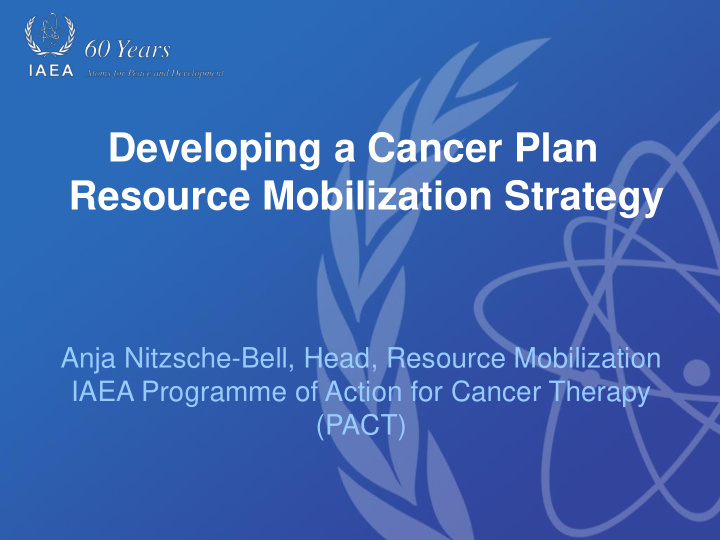



Developing a Cancer Plan Resource Mobilization Strategy Anja Nitzsche-Bell, Head, Resource Mobilization IAEA Programme of Action for Cancer Therapy (PACT)
Overview • Introduction: resource mobilization and strategic planning for national cancer control • Planning steps for developing a robust and sustainable RM strategy, including: – Identifying what is available vs what is needed to address resource gaps – Mapping potential sources for increased funding/support • Examples of innovative financing mechanisms • Recommendations
Developing a Cancer Plan Resource Mobilization Strategy – an integral part of strategic planning for national cancer control 7 Steps 1. Establish governance/coordination mechanisms 2. Define and prioritize evidence-based and cost- effective interventions, based on disease burden, main populations affected, etc. 3. Define effective models of service delivery 4. Conduct cost-estimates of priority interventions 5. Plan resources needed 6. Develop and implement a targeted resource mobilization strategy 7. Implement interventions, monitor and adjust
Resource Mobilization
Health Systems Approach to comprehensive cancer control 90 GAP 80 70 60 50 40 30 20 10 Performance to 0 Coverage with Affordability of Early detection Treatment stage achieve best treatment facility treatment facility coverage presentation (III/IV) possible patient 90 80 outcomes: cancer 70 down-staging 60 50 40 30 20 10 0 Coverage with Affordability of Early detection Treatment stage treatment facility treatment facility coverage presentation (III/IV)
Developing a Cancer Plan Resource Mobilization Strategy Resource Mobilization: “A process of identifying and obtaining resources to help achieve organizational goals and ensure sustainability” Resources for cancer control: Human Resources, Health Infrastructure, Health Technology, Health Financing
Developing a Cancer Plan Resource Mobilization Strategy – Planning Steps 1. Identify what resources are available vs what is needed to determine the gaps 2. Identify potential funding sources 3. Outline best strategies for approaching stakeholders (donors and partners) 4. Identify monitoring and review mechanisms 5. Document activities, ensure quality reporting
What is available – main sources of financing for health • Domestic resources: government budget allocations, social health insurance, private health insurance, out-of-pocket expenditures • External funding: development assistance for health • Targeted revenue raising efforts: innovative financing mechanisms (national/global levels)
International assistance for Health – East Asia and Pacific (2013) – US$2 billion $ 340m $ 200m $ 510m $ 180m $ 230m Institute for Health Metrics and Evaluation (IHME) 2014, University of Washington
International assistance for Health – South Asia (2013) – US$2.8 billion $ 230m $ 300m $ 610m $ 320m $ 420m $ 280m Institute for Health Metrics and Evaluation (IHME) 2014, University of Washington
Innovative Financing Mechanisms • Taxes/Levies (mobile phone, airline, “sin” taxes) • Contributions from high-revenue enterprises (oil, mining, etc.) • Catalyzing private investments/financial products (public private partnerships, “social impact bonds”, socially focused investment products, etc.) • International finance facilities (UNITAID, GAVI, GFATM)
Examples of increased funding for health • Supplementary 2% surcharge tax on tobacco & alcohol = $100 million/year to fund the Thai Health Promotion Foundation. • Compulsory social health insurance in Costa Rica & Indonesia = extended health care to millions. • Global Financing Facility for Every Woman Every Child combines domestic financing with funding from WB, the GFF trust fund & additional donors. • International Finance Facility for Immunizations issues bonds on international capital markets = delivering long-term funding from new sources e.g. institutional investors. (GAVI + GFATM)
WHO framework, 2005
Recommendations To expand resources for National Cancer Plan: • Expand domestic public resources including use of tobacco and other health-related taxes, health insurance schemes and innovative financing mechanisms. Consider the UHC framework. • Complement domestic resources for cancer with official development assistance . • Promote and incentivize financing and engagement from the private sector through public-private partnerships . • Create synergies between cancer and other health priorities: HIV, TB, Hep C, MNCH IMPORTANT: Development of a robust, evidence-based, prioritized and compelling Resource Mobilization Strategy building on a strong Strategic Planning Process for National Cancer Control , broad Partnerships and considering a wide range of Funding Sources
Thank you cancer.iaea.org #CancerCare4All
Recommend
More recommend